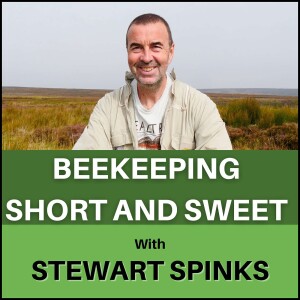
Episode 59: First Spring Inspections Get Started
 2019-04-26
2019-04-26
Hi, I’m Stewart Spinks and welcome to Episode 59 of my podcast, Beekeeping Short and Sweet. We’re finally into some early Spring inspections and I’m gearing up to move some bees to their first nectar flow of the season.
Welcome back and this week has seen that lovely warm early Spring disappear down a rabbit hole and we’re once again back down to more normal temperatures for the time of year. A lot of days over the past week have been down into the single figures, temperature wise and the last couple of days have seen frosts on the truck windscreen which is as much frost as I think I saw all Winter.
I’ve been able to carry out inspections on all of my colonies during that warm spell and I have to say on the whole they are looking really strong and healthy, I have colonies with as many as eight frames of sealed brood ready to explode into life and with our main early nectar flow of Oils Seed Rape just starting to flower it looks as though we might see an alignment of good fortune and a decent early crop of honey.
That said, it’s way to early to be counting jars of honey on the shelf from a crop that’s not yet past 10% in flower, a lot can change between now and then and we have to be careful not to get too far ahead of ourselves.
I posted a lengthy video to my Patreon page showing my first inspections at the University apiary, overall it was a really good inspection but it did throw up a number of questions that I’d like to go over and hopefully give some explanation as to why I did some of the manoeuvres with the hives that I did.
If you haven’t seen the video, it’s available on my Patreon page, check it out here.
I carried out inspections on three very different colonies on video to show my approach to each one. The first was a straightforward single brood box colony, the second was an overWintered nucleus colony still in a nuc box and the third was a colony that had been under-supered for the Winter.
I obviously inspected all of the colonies in the apiary but these were the three I chose to show on the video.
The first colony was the one that had a massive varroa drop when I treated with Oxalic Acid in the Winter, they looked really well and were building up strongly. One of the benefits of this apiary site is the huge amount of early season pollen that’s available to the bees, this means strong, healthy brood and this year the bees were able to get out very early because the weather was so mild. This brings me to the main question that I’ve been asked since posting the video and it revolves around when to add a first super to a colony after Winter.
As with most things in beekeeping it boils down to a judgement call but you can make some initial assessments of the colony and that will help you in making that decision of whether to add a super and queen excluder or not.
When I inspected this colony it was obvious they had grown and were doing well but that alone isn’t enough to make me add a super. What I did notice however, was the large amount of sealed brood that was already present in the brood box which already had a large number of adult bees in it. With so much sealed brood it’s important to remember some of the time lines and numbers. A single frame of brood will produce enough bees to fill a couple of seams between frames so if they emerged over a few days apart they would quickly become congested in a single brood box. It’s easy to see in this colony that the brood had been sealed for several days prior to me inspecting so I would expect the workers to emerge around the time of the next inspection if I were doing weekly inspections. However, with the possibility of the weather preventing an inspection a week later it might be the case that I would inspect for nearly two weeks and by that time the bees would have definitely emerged filling the brood box, becoming congested and potentially triggering a
More Episodes
 2020-09-18
2020-09-18
 2020-09-11
2020-09-11
 2020-09-04
2020-09-04
 2020-08-14
2020-08-14
 2020-08-07
2020-08-07
 2020-07-17
2020-07-17
 2020-05-29
2020-05-29
 2020-05-22
2020-05-22
 2020-05-15
2020-05-15
 2020-05-08
2020-05-08
 2020-05-01
2020-05-01
Create your
podcast in
minutes
- Full-featured podcast site
- Unlimited storage and bandwidth
- Comprehensive podcast stats
- Distribute to Apple Podcasts, Spotify, and more
- Make money with your podcast
It is Free
- Privacy Policy
- Cookie Policy
- Terms of Use
- Consent Preferences
- Copyright © 2015-2024 Podbean.com




